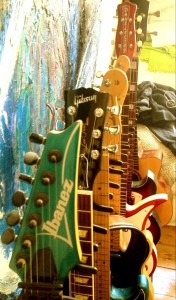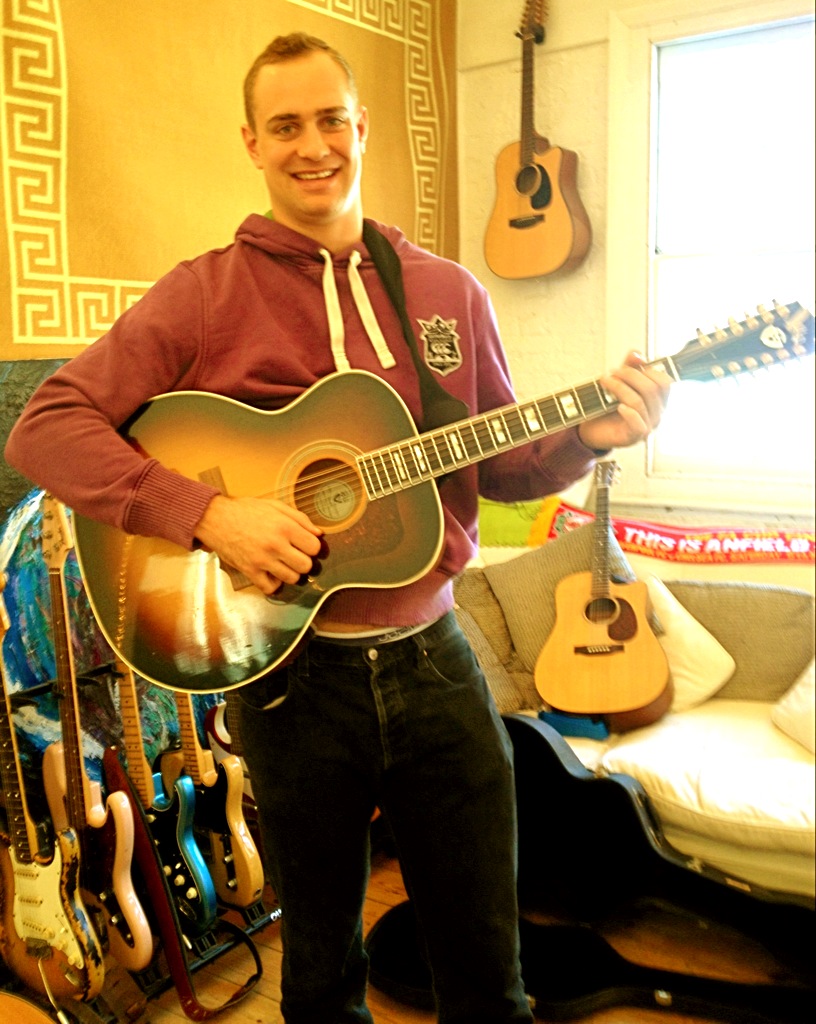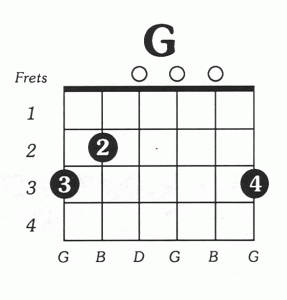Chord Theory
Think of all the great songs you know and all the wonderful guitar players you have heard.The reason they resonate so much with you is because they write magical chord progressons or riff & licks you connect with.These songs become the soundtrack to your life.The emotional impact they have of on you is specific and can focus and effect your mood instantly.The following thoughts are to do with the mathematical element conected to music and how chords are made or constructed.Chords are the vertical arrangement of notes from a scale. The study of chords is called Harmony. Harmony is concerned with how one or more notes interact, and how they follow each other.
Many people define chords as several notes played simultaneously. It must be pointed out that it is possible to play music of a chordal nature on the flute, trumpet, or a lone human voice, all three being monophonic instruments. Since obviously monophonic instruments cannot play a stacked chord where the notes are sounded simultaneously; the chords are implied. A simpler way of viewing this is that when chord tones are played as an arpeggio on a monophonic instrument the human ear interprets that there is a harmonic structure. We therefore define a chord as the basic element of harmony. To start with we will look at examples of the most basic chord, the triad.
The triad is a class of chords, specifically three-note chords formed by this formula: 1-3-5 or root, third, fifth. In this example they are constructed of two consecutive thirds.
There are four kinds:
| Root | 3rd | 5th | |||||||||||||||||||||||||||||||||||||||||||||||||||||||||||||||||||||||||||||||||||||||||||||||||||||||||||||||||||||
|---|---|---|---|---|---|---|---|---|---|---|---|---|---|---|---|---|---|---|---|---|---|---|---|---|---|---|---|---|---|---|---|---|---|---|---|---|---|---|---|---|---|---|---|---|---|---|---|---|---|---|---|---|---|---|---|---|---|---|---|---|---|---|---|---|---|---|---|---|---|---|---|---|---|---|---|---|---|---|---|---|---|---|---|---|---|---|---|---|---|---|---|---|---|---|---|---|---|---|---|---|---|---|---|---|---|---|---|---|---|---|---|---|---|---|---|---|---|---|---|
| Major | 1 | 3 | 5 | ||||||||||||||||||||||||||||||||||||||||||||||||||||||||||||||||||||||||||||||||||||||||||||||||||||||||||||||||||||
| Minor | 1 | ♭3 | 5 | ||||||||||||||||||||||||||||||||||||||||||||||||||||||||||||||||||||||||||||||||||||||||||||||||||||||||||||||||||||
| Augmented | 1 | 3 | #5 | ||||||||||||||||||||||||||||||||||||||||||||||||||||||||||||||||||||||||||||||||||||||||||||||||||||||||||||||||||||
| Diminished | 1 | ♭3 | ♭5 | ||||||||||||||||||||||||||||||||||||||||||||||||||||||||||||||||||||||||||||||||||||||||||||||||||||||||||||||||||||
| ♭=flat/lowered; #=sharp/raised If we juxtapose these three notes (the root, major third and perfect fifth) they can be structured or ‘voiced’, C-E-G, E-G-C or G-C-E. No matter what order the three notes (called voices) are in they still create a C major chord. It does not matter if the voices are the singers in a choir or the instruments of an orchestra, if the notes are all either C, E, or G we simply have a gigantic sounding C chord.The two consecutive intervals produced by these voicings would be:
If the root (C) is on the bottom this voicing is called root position. If the third (E) is on the bottom it is called first inversion. If the fifth (G) is on the bottom this voicing of the triad is called second inversion. Since there are only three possible voicings of a triad it is relatively easy to hear them in that they are a common feature of the past two centuries of traditional harmonic structures in Western music. The use of the exponentially more complex voicings arising from 4-voice, 5-voice and larger chords is more challenging. Some 4-voice chords are used in traditional, ‘classical’ and church music but others such as the diminished seventh were strictly forbidden in early sacred music as they contained the tritone interval; the mathematical halfway point in the octave which allegedly sounded Satanic. Other 4-voice chords were not used in symphonic and ‘classical’ music until the French Impressionist era and in modern jazz. All triads and 4-voice chords are built within the octave, or eight-note scale which encompasses the do-re-mi-fa-sol-la-ti-do of the major scale, for instance, or the scale steps 1-2-3-4-5-6-7-8; eight being the octave where the pattern starts over again. All triadic and therefore, common, chords can be constructed the same way : using the 1 3 5 formula. Take the C scale, for instance :
This works for any scale, and whether the chord formed is minor or major depends on the scale: the I, IV, V chords are major, and the rest are minor, with the seventh being diminished. Some Four-Voice Chords
IntervalsAll chords are made up of interlocking or overlapping intervals. An interval may be defined as the distance between two notes. The names of the chords are derived from the intervals that they are built from. In order of smallest to largest the ascending intervals (and distance in semitones) within the octave from a middle C would be as follows:
The dreaded tritone, six semitones up from the root (and six down from the octave), is harmonically bewildering, being neither fish nor fowl, exactly halfway from nowhere; one interval with two names (enharmonic in 12-tone equal temperament), the augmented 4th and the diminished 5th. Likewise, the enharmonic augmented 5th and minor 6th are eight semitones up from the root. By observing that 2nds, 3rds, 6ths and 7ths are always either major or minor and 4ths and 5ths are always perfect, augmented (raised) or diminished (lowered) it becomes evident that major chords have a major 3rd, minor chords have a minor third, et cetera. By altering or manipulating these intervals by raising or lowering the third, fifth, seventh, and so on, all of the possible chords can be produced. Some examples:
Applying chordsThe easiest way to apply a triad, or indeed any chord, is to pick one on a polyphonic instrument (such as a piano) and play its three notes simultaneously. This is often how chords occur in actual music: an instrument plays all the notes in the chord at the same time. However, there are other possibilities. The simplest is to arpeggiate the chord, that is, to play its notes one at a time in any order, especially in a ascending or descending order. Often a melody can be written around the chord, using notes in the chord as well as a few other nearby notes in the chord’s scale. When this is done while there is no accompaniment actually playing a chord, the chord is implied. I never met a musician who regretted being one… -Virgil ThomsonSeventh chordsTriads are often extended with some form of the seventh to form a seventh chord. When a chord is referred to as simply a seventh chord, usually the dominant seventh is meant, which is a major triad with a minor seventh, for instance, C-E-G-B♭. It is called the dominant seventh because the V chord, or “dominant chord” in the Latin naming system, is the only major chord in the major scale that can naturally contain a minor seventh. Because all sevenths are dissonant intervals, any seventh chord is dissonant, in other words, a seventh chord is more tense than a major or minor chord. However, a few styles of music, such as jazz, make heavy use of seventh chords and may treat them as rather consonant. Other chordsSome chords are defined by the relation to the key rather than by any inherent characteristics. The Neapolitan chord, for example, is an ordinary major chord, but its root is the lowered supertonic of the corresponding key, so the Neapolitan of C major is a D♭ major chord. Additionally, the Neapolitan is usually found in first inversion. A borrowed chord is one from the parallel major or minor key. In C major, the parallel key is C minor and borrowed chords include E♭ major, B♭ major, and F minor. |
|||||||||||||||||||||||||||||||||||||||||||||||||||||||||||||||||||||||||||||||||||||||||||||||||||||||||||||||||||||||
| major | (none) | 1 3 5 | C | C E G | |
| minor | m | 1 b3 5 | Cm | C Eb G | |
| dominant 7th | 7 | 1 3 5 b7 | C7 | C E G Bb | |
| diminished 7th | dim or o | 1 b3 b5 6 | Cdim | C Eb Gb A | |
| minor 7th | m7 | 1 b3 5 b7 | Cm7 | C Eb G Bb | |
| augmented 5th | aug or + | 1 3 #5 | C+ | C E G# | |
| major 7th | Maj7 | 1 3 5 7 | CMaj7 | C E G B | |
| major 6th | 6 | 1 3 5 6 | C6 | C E G A | |
| dominant 9th | 9 | (1) 3 5 b7 9 | C9 | (C) E G Bb D | |
| minor 6th | m6 | 1 b3 5 6 | Cm6 | C Eb G A | |
| suspended | sus | 1 4 5 | Csus | C F G | |
| 7th suspended | 7sus | 1 4 5 b7 | C7sus | C F G Bb | |
| dominant 7th w/ aug. 5th | 7+5 | 1 3 #5 b7 | C7+5 | C E Ab Bb | |
| dominant 7th w/ flat’d 5th | 7-5 | 1 3 b5 b7 | C7-5 | C E Gb Bb | |
| minor 7th w/ flatted 5th | m7-5 | 1 b3 b5 b7 | Cm7-5 | C Eb Gb Bb | |
| major 9th | Maj9 | (1) 3 5 7 9 | CMaj9 | (C) E G B D |
Guitar Lessons London @ London Guitar Academy home of guitar tuition & Music Theory in London
Here are some GREAT CHORD PROGRESSIONS
http://www.youtube.com/watch?v=xdCrZfTkG1c&feature=share
http://www.youtube.com/watch?v=WsKPPL-j6kE&feature=share
http://www.youtube.com/watch?v=VbpMpRq6DV4&feature=share











